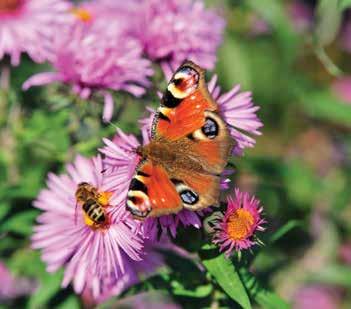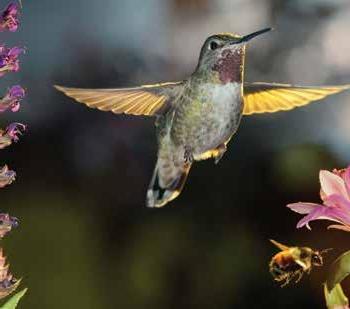
16 minute read
Welcome to Candle
Welcome to Candlewood
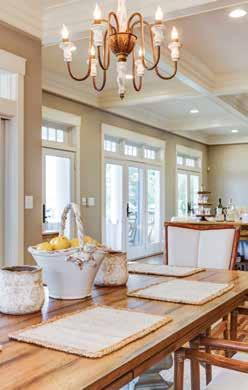
RE-CREATING A CHERISHED FAMILY VACATION HOME
By Lisa J. Gotto | Photography by Liz Baker
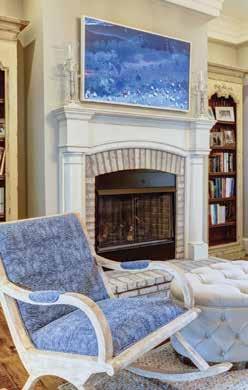
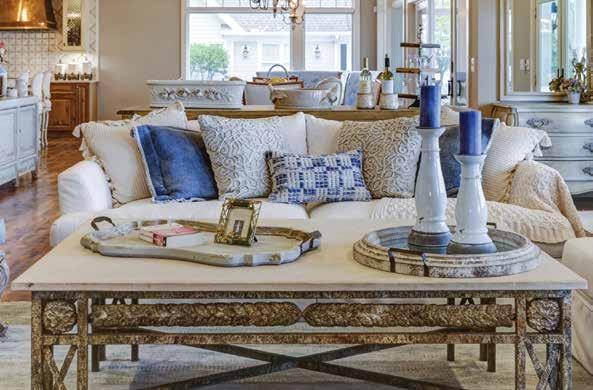
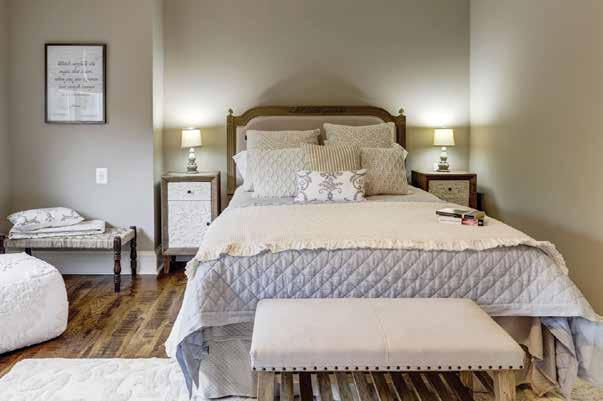
mong Janet Pace’s fond memories of growing up is one particular sound—the sound of a creaky screen door slamming. It originated from a special place, the home of her grandparents located near Candlewood Lake in Danbury, Connecticut.
“I just loved hanging there with my boy cousins; I was the only girl in our family. So I would know when they were going outside to play ball…I would hear the screen door slam,” she says.
While this and other memories associated with that home and the time spent there with family have always been precious, it was after her father’s passing a few years ago that she started envisioning re-creating such a place, as a vacation home.
Janet and her husband, Andy, an attorney, live in Potomac, but have always loved the quaint Eastern Shore town of St. Michaels. It was here that they decided to put down vacation home roots when they discovered a property along the Miles River that they felt was just perfect for building their homage to her father, and reminiscent of her grandparents’ lake house. The family now refers to this home as “Candlewood.”
So, from the start it was understood that this new build would be far from cookie-cutter, creating not only a treasured vacation retreat for the couple and their three grown daughters, but a home for the priceless items that Janet has saved, salvaged, and found over the course of a couple decades.
This was one of the design challenges posed to Brent Paquin, President and Chief Designer of Paquin Design/Build of Grasonville, and his team. “On this project, we were working with a client with a very specific vision and it was our job to pull it together,” Paquin says. “Among other things, we were challenged with integrating her antique and vintage pieces into a ‘new home’ environment and having them appear as if they had been there for years.”
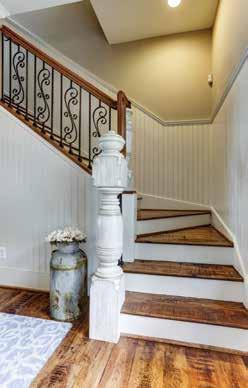
In the beginning, the Paces approached Paquin with an image from the film, Something’s Gotta Give, starring Diane Keaton, and that’s when Brent went to work. As a custom home builder and designer for almost 20 years, Paquin says he thrives on this type of unique opportunity and was able to incorporate all of Janet’s ideas into an original design inspired by that one photograph.
“From an architectural standpoint, the layout is great,” Paquin says. “It’s open and spacious, with plenty of room for a growing family. For the exterior, we chose James Hardie shingled siding to mimic the cedar shake style of the home she had envisioned. Substantial Georgian columns were added to the front entrance, and at the back of the house lining the covered porch, which overlooks the Miles River.”
Inside, you can see similarities in the overall palette, window styles, ceiling treatments, the layout and décor chosen for the family/great room, and some touches upstairs in the spacious five-bedroom dwelling.
REPURPOSE APPEAL
What makes this house so much more than a home and ever so unique are the depths of its details. That would not be possible without Janet’s exquisite design sensibilities and her determination to make what she has cultivated and collected over the years work. She is quick to point out, however, that it would not have been possible without the hard work and dedication of the interior design team at Paquin.
“Dawn (Crovo), their interior designer, and I went and looked for everything together,” Janet explains. “I had my own ideas and she helped enhance my vision through her creative suggestions.” Crovo knew that her main objective was to make this new home look old, and in the end, was able to help the Paces incorporate many features and finishes that captured that character and charm.
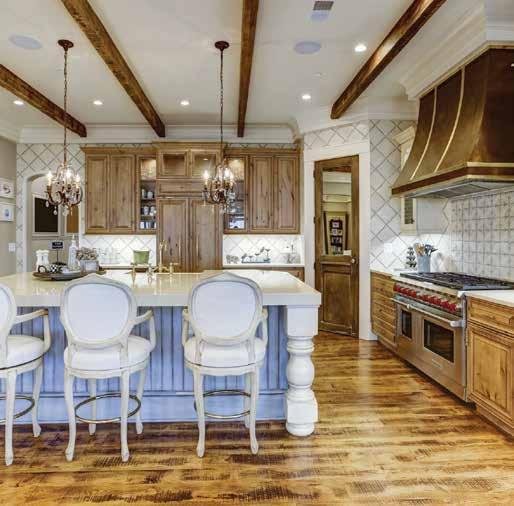

Repurposed, honey chestnut-finished barnwood floors laid the foundation for the rest of the home’s details. Starting at the front door, custom-designed oversized balusters were made for the staircase, wooden beams were added to the kitchen, old-fashioned tin and shiplap were applied to ceilings, and hallways were bead boarded ; all of these features working together to make what is new, old.
A PINCH OF THIS AND A DASH OF THAT
There is no better place to discern the depths to which this home is detailed than in its custom kitchen. Like any great, time-tested family recipe, there’s usually a pinch of this and a dash of that that go into making something everyone loves; and that was Janet’s goal, to create a space that her family would enjoy gathering in for generations.
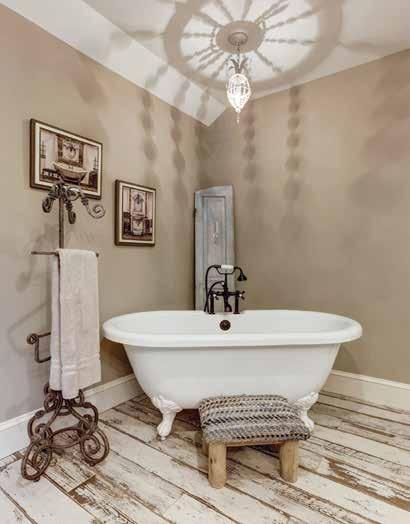
To do so, she took stock of how her family lives and stirred in all the things she loves. A key component in the kitchen is the mixture of cabinetry. With her keen eye for salvaged finds, Janet was able to acquire eight matching pieces of custom kitchen cabinetry, some with glass front inlays at Second Chance in Baltimore, a nonprofit organization she is happy to support.
“Everyone they employ has at one time in their life been incarcerated and is trying to turn their lives around, and has been given a second chance,” Janet conveys. “So I got this entire custom kitchen that someone must have ripped out.”
Working with Crovo, the two were able to integrate several of these beautiful buttercream-colored cabinets into her kitchen design. Other pieces of this set were repurposed throughout the house, including the nearby mudroom where they put the largest cabinets to use for storage. Janet chose cabinets of alder wood to balance out her storage opportunities in the kitchen.
The copper range hood was a must-have for Janet after seeing an example of one in a design publication. Sourcing this piece would not be easy, however, because the chosen manufacturer was located on the West Coast and shipping that exact one would have been a budget buster. Fortunately, an equally beautiful alternative was located.
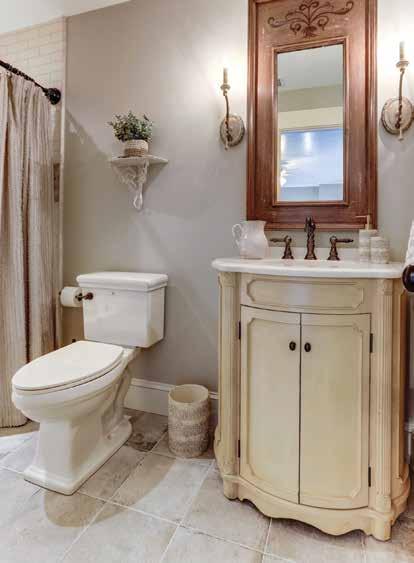
Just above the range is a backsplash of weathered-looking Tabarka tile that Paquin was able to order from Italy. The tiles provide one of the ever-so-subtle touches of a watercolor blue to the room, a palette she carries throughout the French Provencal living space.
“I fell in love with the imperfections in the tile, as I believe imperfection equals beauty,” Janet says.
Central to the room is the kitchen’s sizeable island with its lustrous slab of creamy quartz and farmhouse sink. This feature is highlighted with a beadboard base that she had an artist friend hand-paint for her—again in a complementary tranquil blue.
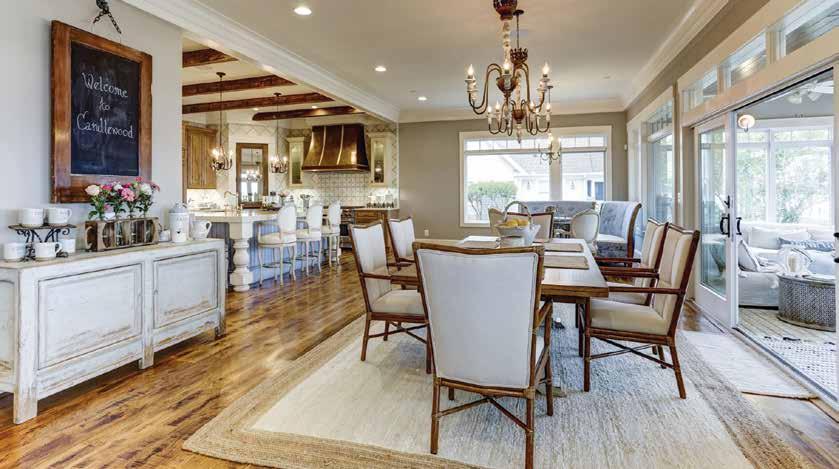
The island seats five and mixes two types of chairs; one with sea grass rope detailing on the back and the others match the style of three chairs in the adjacent breakfast nook.
Other features in the kitchen that add warmth are accent walls of another style of Tabarka tile placed in a diamond pattern, rustic wood beams, antique oval door knobs, (a detail used throughout the home) and an antiqued pantry door with a mercury mirror inset.
“I wasn’t sure about the mirrored inset, but I thought if I’m in the kitchen, then I could see what’s going on everywhere else,” Janet says.
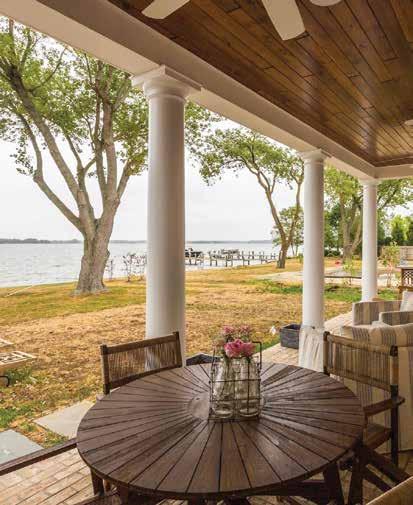
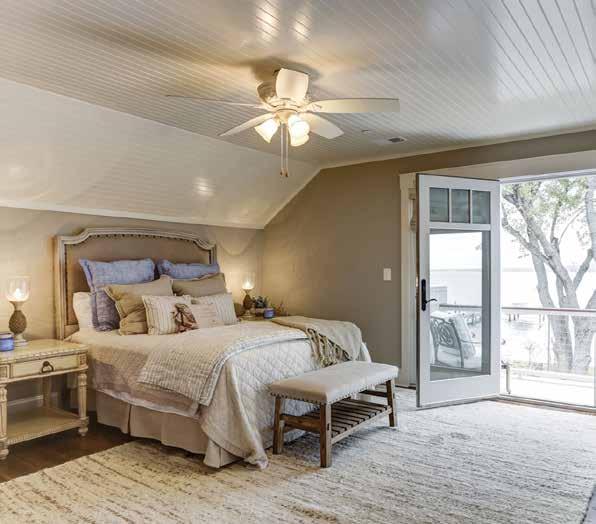
Indeed, from here she can easily keep on an eye on their fur babies in the reading room, a pair of Yorkshire Terriers named Zoey and Stella, who enjoy relaxing in this space dedicated to her favorite books shelved on two Habersham bookcases framing the fireplace—which also received hand-painted touches from Janet’s artistically-gifted friend.
MAKING IT ALL FIT
The dining area and adjacent great room offered her a place to really work in aspects of her grandparents’ house. Above the sideboard in the dining room that they use as a coffee bar is a vintage chalkboard that reads “Welcome to Candlewood” — a great way to evoke memories for guests and family.
“We love entertaining. We’re the kind of entertainers that want our guests to come and stay, and feel like it’s their home,” Janet says.
But her favorite way to evoke memories remains with the feature Janet asked Paquin to install; a heated four-season room, which looks out to the river. Detailed with taupe brick floors and warm wooden-planked ceilings, the room has been finished with a cozy corner couch and a game table awaiting players up for a challenge.
“I said to Paquin when we were building the home that I would want a wooden screen door in this room because I would need to hear that screen door slam when I have little grandchildren going out there someday,” Janet explains.
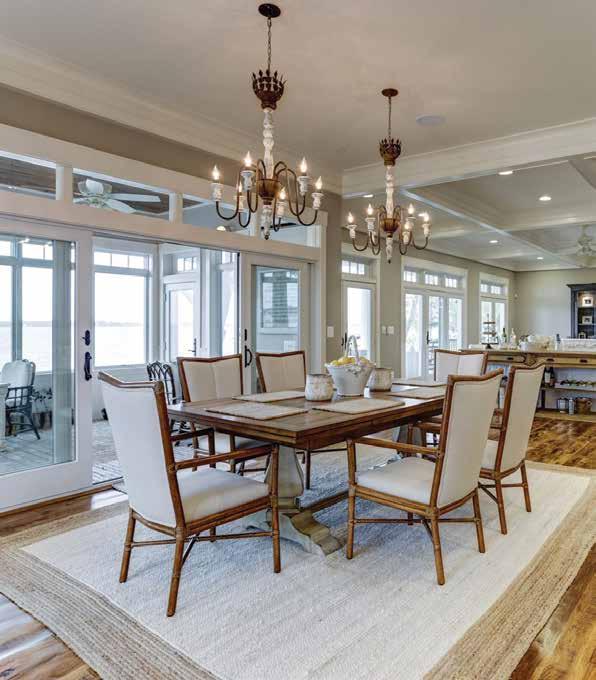
With that added to the list, Paquin continued to work on other aspects of the home that would help turn it into the place that would make Janet’s grandparents proud. The rest of the salvaged custom kitchen would become vanity drawers, a long-held jelly cupboard would be recessed into a guest bathroom wall, and an old barrister’s bookcase from her husband’s office would be re-painted and repurposed so it could be used in another bathroom. And, as one final salute, the couple’s office was filled with treasures from Janet’s father, a West Pointer and retired three-star general.
The plan and the dream to re-create the feel of the Candlewood Lake house was well on its way to fruition— nostalgic noises and all.
In fact, this summer we fully expect that somewhere in St. Michaels if you listen closely, you can hear the echo of a screen door slamming across the Miles River.
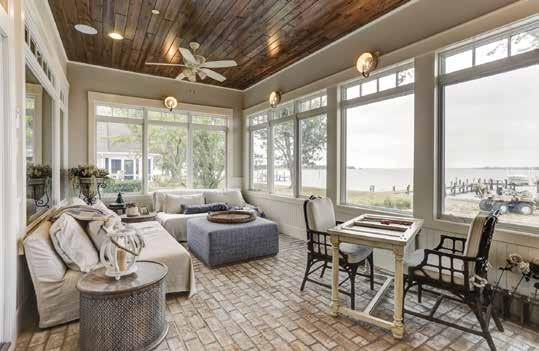
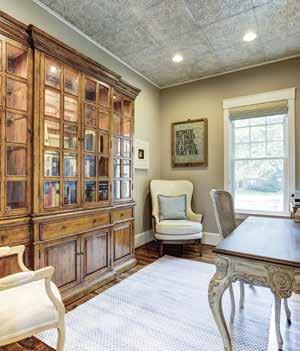
Gardening’s For the Birds…
AND THE BEES, AND THE BUTTERFLIES TOO
By Janice F. Booth
As summer draws to a close, we can look ahead to autumn’s delights. One of fall’s pleasures may be enjoying your fall garden. The little joys—the unremitting blooms of the Black-eyed Susans, the tender roots of that Boxwood twig you planted, and, hopefully, the call of the Canada geese winging their way south. I hope, dear reader, that you and I can hold onto some of the insights we gained from our months of self-isolation and apply those insights now and in the future—how satisfying it became to simply watch the trees bud and leaves emerge. What a simple pleasure, having the time to watch the squirrels scamper across the telephone wires and the birds nibble at your feeder.
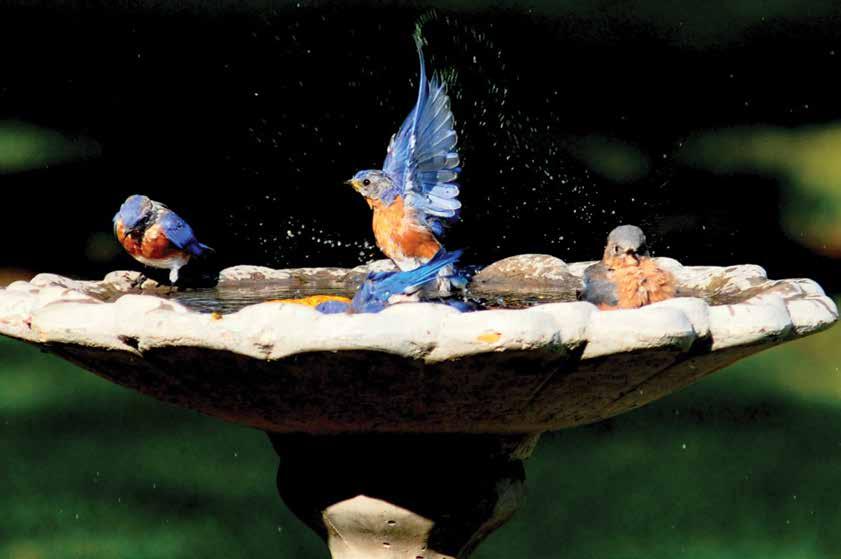
Let me propose an easy and satisfying project based on our reawakened enjoyment of life’s simple pleasures. Why not devise adaptations to our gardens, patios, or decks to make these areas even more welcoming to those songbirds, bees, and butterflies that have entertained us during our long sequestration? Some of those little, feathered balls of energy may winter over here in Maryland while others can be enticed to return next spring to our welcoming gardens.
WHY GARDEN WITH BIRDS, BEES, AND BUT TERFLIES IN MIND?
There are at least five solid reasons for encouraging these tiny creatures to visit your garden. Birds and butterflies entertain and delight us. (Honey bees, too, can prove entertaining—at a safe distance, of course.) There is the simple pleasure of watching them zoom in to rest on a railing or perch on your feeder. What are they thinking as they select the perfect seed, cooperating with one another or pushing each other out of the way—not unlike kids on the playground. How does that delicate splash of color emerge from its dull cocoon? The minor-key song of the Chickadee, the melodic chirrups of the Song sparrow, the hearty songs of the Robins fill the day. There’s also the particular pleasure of learning
to identify the birds that visit our feeders. Is that a House finch or a Purple finch? Am I listening to the Cardinal’s song, or is that a Robin? How does that Nuthatch hang on as he skitters, head down the trunk of that oak? It always takes my breath away, watching a tiny Goldfinch undulate like a yellow snake across the sky. As we learned during our forced confinement, there is a great deal to be observed, if we have the time and the patience.
Another compelling reason to provide for the birds, bees, and butterflies is the work they do in our gardens. They are the seeders and pollinators. They carry the potential for new plants and the magic dust that allows plants to flower and reproduce. Without the pollinators our mums and asters would never bloom, our fruit trees would bear no fruit.
Tired of swatting at those pesky flies and mosquitoes? Avoiding those smelly sprays and noisy bug-zappers? Well, leave it up to the birds! Their favorite meal may be a juicy fly or a crinkly mosquito! Birds dine on those nasty aphids and mites that can plague our plants. Woodpeckers, finches, chickadees, and (here’s an easy one) flycatchers eat oodles of insects every day; picking off a fly on the wing is a favorite pastime for a swallow. Barn swallows will eat over 1,000 insects per day! But they’re light eaters when compared to the Purple martins which eat 2,000 mosquitoes per day. No wonder folks put up those pretty apartment-birdhouses designed specifically for Purple martins!
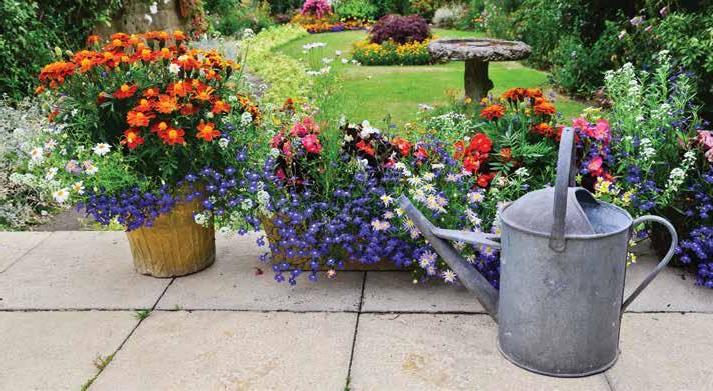
Birds can also save you some work in the flowerbeds. Ground feeders, like finches, towhees, and sparrows eat the seeds of future weeds, eliminating or at least diminishing the number of weeds you’ll do battle with in your flowerbeds.
Finally, some of those more impressive raptors— hawks, owls, and kestrel— will help keep down the rodent population. These sharp-eyed hunters eat mice, voles, squirrels, and snakes. (Sorry about the squirrels.) A nesting pair of Barn owls eats over 3,000 rodents during their mating season. A hawk eats one or two large rodents each day. And for all of us struggling with voles beneath our lawns and in our gardens, hear this! Kestrels eat 4–8 voles each day, depending on the season! (They’re welcome to all the voles in my lawn.)
HOW CAN I ENCOURAGE THE BIRDS, BUT TERFLIES, AND BEES TO VISIT MY GARDEN?
There are only four essentials for making your garden, patio, or terrace a welcoming habitat for these visitors.
FOOD: You can, of course, set up bird feeders and buy bags of birdseed. This is a great way to draw birds in, so you can get a closer look at them. A few cautions, however: If you are successful, buying seed to keep your hungry guests well fed can get expensive. Also, if you begin supplying a feeder, you need to continue refilling it. The birds that visit will come to rely on your largesse. If your feeder goes empty for too long, your feathered friends might suffer. And, prepare for cleanup duty. The birds will be a bit cavalier in their exploring of your feeder, tossing seeds hither and yon. You’ll have to keep a broom and dust pan handy or your patio floor will look like the floor in a saloon that offers free peanuts—unshelled. Bees and butterflies need only flowers—trumpet vines, sunflowers, petunias, and roses. No clean-up necessary.
WATER: A reliable water source will be a valued gift for your visitors. A few plastic flowerpot saucers will do—you’ll have to dump and refill them often. A birdbath is a charming, old-fashioned solution. They’re usually a bit larger and will hold enough water for a few days. Either choice must be shallow. The birds need to be able to stand on the rim or a rock in the birdbath. A major project that offers a lovely solution is adding a pond to your garden. A pond provides essential water for all the small creatures that share your neighborhood—birds, butterflies, foxes, raccoons, and rabbits.
SHELTER: Here’s the excuse for all of us who are lazy gardeners. Resist a too-tidy garden or flowerbed. Birds, bees, and butterflies need places to hide and shelter from predators and weather. You’ll provide essential shelter if you leave a few forsythia to run wild or create a small wood pile with those fallen branches you collect. There are plans on-line for clever insect apartment buildings you can create and install in your garden. SAFETY: Whether you’re figuring out where to hang the feeder or locate the birdbath, consider the safety of the birds as they rest. If there are cats and dogs in your household or neighborhood, you will need to consider height—how tall a base will be needed to keep the cat from jumping into the birdbath? If you hang the birdfeeder from a tree, how far out on a branch should you go to keep squirrels from easily jumping into the feeder?
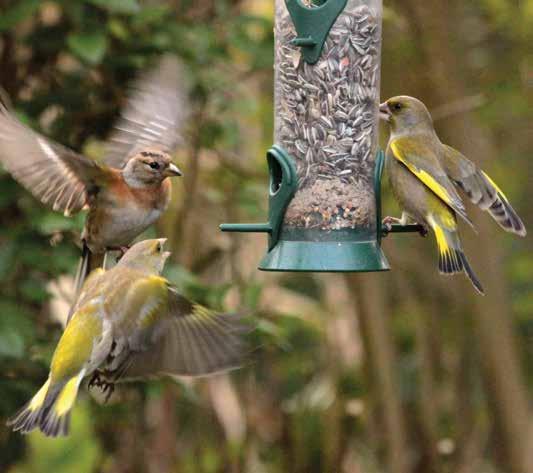
And, speaking of squirrels, as we gardeners face the unremitting struggle to keep squirrels out of our flowerpots, birdfeeders, and bulbs, let me offer a few suggestions for squirrel-repellants.
NATURE’S SOLUTION: Try planting some or all of the following flowers in your garden. Squirrels are repelled by: • Allium • Geraniums • Hyacinths • Lilies of the Valley
• Snowdrops
KITCHEN CONCOCTIONS:
1. Hot stuff: Mix 1/3 cup of flour, 2 tablespoons of Cayenne pepper, and 2 tablespoons of powdered mustard. Sprinkle the powder around birdbaths and feeders. The birds won’t be bothered, but the squirrels may! 2. Wet stuff: Mix equal quantities of water and vinegar. Spray areas where you wish to repel the squirrels. You can also try adding peppermint oil or garlic. With over 400 species of birds sighted in Maryland, and almost 300 of them fairly common, what are we waiting for? Hold onto those quiet hours when you can sit and observe the world around you—feed the birds, watch the bees move delicately from flower to flower, catch your breath as a golden Monarch butterfly visits your purple asters. And when winter comes, you’ll still find a few old friends looking to you for seeds when snow and ice blanket the earth.
